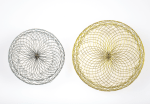The world population is aging, and cardiovascular diseases are the leading cause of death in Western countries. It is increasingly common to find patients aged 70 or older with non-ST-segment elevation acute myocardial infarction (NSTEMI). However, this group has been excluded from most studies, and there is not enough information to determine whether a conservative...
QFR Analysis of Coronary Lesions with TAVR
While transcatheter aortic valve replacement (TAVR) has shown benefits, significant coronary artery disease affects 50% or more of patients who undergo such procedure. However, it is still unclear which is the best treatment strategy or how to handle this condition. Quantitative flow ratio (QFR) could be a non-invasive option to assess the severity of coronary...
Events in CAD Patients Who Refused or Were Ineligible for CABG
When deciding on the optimal coronary artery revascularization treatment of coronary artery disease (CAD) patients, physicians normally assessed clinical presentation, surgical risk, survival expectation, and the likelihood of a better quality of life. Decisions are made after careful consideration, by the Heart Team, who will ponder options such as coronary artery bypass graft (CABG), percutaneous...
Glycemic Control and Coronary Stent Failure
Diabetic patients have twice as high a risk of developing coronary artery disease (CAD). Additionally, CAD increases mortality risk. Patients with a history of percutaneous coronary intervention (PCI) tend to need repeat revascularization, even with second generation stents. To date, there are few studies assessing the role of glycemic control in stent failure, stent thrombosis,...
Sirolimus-Eluting Balloon in Femoropopliteal Disease
Drug-eluting balloons (DEB) with paclitaxel have shown efficacy and safety in the treatment of femoropopliteal disease. Sirolimus-eluting balloons (DEB S) are currently being introduced. This new drug acts during the cellular resting phase (G0) and is considered potentially more effective than paclitaxel, which is a cytostatic drug. However, there is no conclusive evidence in this...
BIONYX: Onyx vs. Orsiro At 5 Years
Onyx is a zotarolimus-eluting stent (ZES), designed with thin struts and a platinum core that enhances its radiological visibility. This can be beneficial in complex situations with limited visibility, such as in patients who are obese or present severe calcification, two particularly frequent characteristics in diabetic or elderly patients. The BIONYX study was a randomized...
CART Technique for Chronic Total Occlusions
The retrograde technique has significantly improved the success of percutaneous treatment of chronic total occlusions (CTO). After crossing a collateral channel, creating a connection between the anterograde and retrograde systems is key. The most common technique for this is reverse controlled antegrade and retrograde subintimal tracking (reverse CART). This technique involves inflating a balloon over...
Microvascular Resistant Reserve: Impact on STEMI Patients
Coronary Microvascular Dysfunction (CMD) is being increasingly considered a common consequence of STEMI. Its presence partly explains the persistence of angina symptoms in over 50% of patients after PCI, despite successful epicardial artery reperfusion. Also, CMD has been independently associated with worse left ventricular ejection fraction recovery, which leads to worse prognosis, including recurrent events,...
Evolution of Leak in Left Atrial Appendage Closure
Atrial fibrillation is common in elderly people and is associated with a higher risk of ischemic stroke. Left atrial appendage occlusion (LAAO) is a valid strategy, especially in patients at high risk of bleeding. The presence of peridevice leak (PDL) has been linked to stroke, although some analyses, such as the PROTEC-AF Study, suggest that...
TAVR in Bicuspid Valves
Bicuspid aortic valve (BAV) disease affects 1%-2% of the population and manifests with severe aortic stenosis in the middle-aged. It characterizes for a very different anatomy with more calcification than the tricuspid aortic valve. At present, surgical aortic valve replacement (SAVR) is the first treatment indication. TAVR in this scenario has shown, in different studies,...









